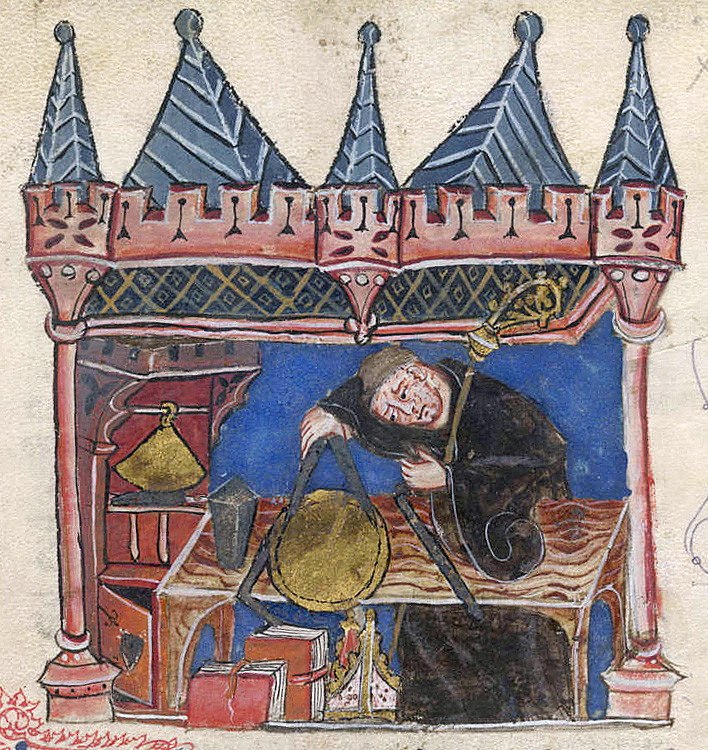- Richard of Wallingford
Infobox Person
name = Richard of Wallingford

image_size = 250px
caption = Richard of Wallingford is measuring with a pair of compasses in this 14th century miniature.
birth_date = 1292
birth_place =Wallingford ,England
death_date = 1336
death_place =St Albans
occupation =Astronomer , Horologist andMonk
parents = Father- aBlacksmith :"For the Constable of Wallingford Castle, seeRichard of Wallingford (constable) ".Richard of Wallingford (1292–1336) was an English mathematician who made major contributions toastronomy /astrology andhorology while serving asabbot ofSt Albans Abbey inHertfordshire .Richard was born, the son of a
blacksmith , atWallingford inBerkshire (nowOxfordshire ) inEngland . When he wasorphan ed he was taken to William de Kirkeby thePrior of Holy Trinity Priory. Richard subsequently spent 6 years studying atOxford University before becoming a monk at St Albans. He later studied for 9 more years at Oxford. In 1326 he becameabbot of St Albans .Richard of Wallingford is best known for the
astronomical clock he designed, while he was abbot, which is described in the "Tractatus Horologii Astronomici" (1327). The clock was completed about 20 years after Richard's death by William of Walsham but was apparently destroyed duringHenry VIII 's reformation and the dissolution of St Albans Abbey in 1539. His clock almost certainly was the most complexclock mechanism in existence at the time in theBritish isles , and one of the most sophisticated ones anywhere. The only other clocklike mechanism of comparable complexity that is documented in the 14th century is theastrarium by Giovannide Dondi . Based on the 14th century literary evidence in the 20th century several scholars of horological history have tried to build recreations of Richard of Wallingford's clock. The best known of these for many years was displayed at theTime Museum (now defunct) inRockford, Illinois ; one was built byEric Watson and is now in theWallingford Museum , and one built in 1988 is located atSt Albans Cathedral .Richard also designed and constructed a calculation device, known as an
equatorium , which he called Albion. This could be used for astronomical calculations such as lunar, solar andplanet arylongitude s and could predicteclipse s. This is described in the "Tractatus Albionis". He published other works ontrigonometry , celestial coordinates, astrology, and various religious works.Richard suffered from what was then thought to be
leprosy (although it might have beensyphilis ,scrofula ortuberculosis ) which he apparently contracted when he went to have his position as abbot of St Albans Abbey confirmed by the Pope atAvignon . He died atSt Albans .Richard of Wallingford, abbot and mathematician is not to be confused with the later Richard of Wallingford, constable of
Wallingford Castle , and supporter ofWat Tyler in theEnglish peasants' revolt of 1381 .References
*North, J. (2004) God's Clockmaker: Richard of Wallingford and the Invention of Time. Oxbow Books. ISBN 1-85285-451-0
*North, J. (1976) Richard of Wallingford - Volume I Texts and Translations, Volume II - The Life of Richard of Wallingford - Introductions and Commentaries to Text, Volume III - Illustrations, Tabels, Appendexis, Glossaries, Bibliography and Indexes; An edition of his writings, with introductions, English translation and commentary, Oxford Univ Press. ISBN 0-19-858139-4
*Watson, E (1979) The St Albans Clock of Richard of Wallingford. "Antiquarian Horology", Number 4, Volume 11, Summer 1979, p.372-384.*citeweb|url=http://www.berkshirehistory.com/bios/images/rwallingford.jpg|title= Richard of Wallingford|accessdate=5 May|accessyear=2008
*citeweb|url=http://www.imagesonline.bl.uk/britishlibrary-store/Components/63/6371_1.jpg|title= Miniature of Richard of Wallingford|accessdate=5 May|accessyear=2008
*citeweb|url=http://www.stedmundsbury.gov.uk/sebc/visit/images/9586251.jpg|title= Astronomical Clock, Originally designed by Richard|accessdate=5 May|accessyear=2008
*citeweb|url=http://www.nicholaswhyte.info/row.htm|title= The Astronomical Clock of Richard of Wallingford, essay by Nicholas Whyte|accessdate=1 July|accessyear=2008
*citeweb|url=http://surfin_dude.tripod.com/creative/clocks/wallingford/stalban.html|title= Richard of Wallingford and the Clock of St. Albans, by Deryl Bender|accessdate=1 July|accessyear=2008
ee also
*Giovanni
De Dondi
*Yi Xing
*Su Song External links
* [http://www.wallingfordclock.talktalk.net The Wallingford Clock at St Albans Cathedral]
* [http://www.nicholaswhyte.info/row.htm The Astronomical Clock of Richard of Wallingford]
* [http://www.imagesonline.bl.uk/britishlibrary/controller/subjectidsearch?id=9664 Images of Richard of Wallingford and the Astronomical Clock of Richard of Wallingford from the British Library]
* [http://uk.geocities.com/david.hemming1@btinternet.com/history Wallingford History Gateway]
* [http://www.berkshirehistory.com/bios/rwallingford.html Royal Berkshire History: Richard of Wallingford]Persondata
NAME= Richard of Wallingford
ALTERNATIVE NAMES=
SHORT DESCRIPTION= English mathematician
DATE OF BIRTH= 1292
PLACE OF BIRTH= Wallingford, England
DATE OF DEATH= 1336
PLACE OF DEATH= St Albans
Wikimedia Foundation. 2010.
